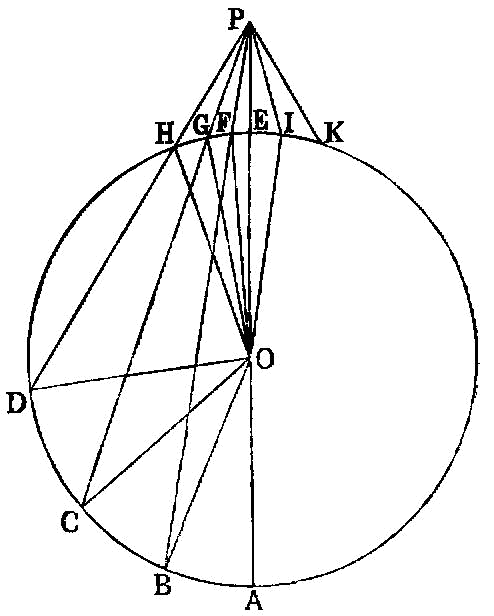Proposition 3.8

If a point be taken outside a circle and from the point straight lines be drawn through to the circle, one of which is through the centre and the others are drawn at random, then, of the straight lines which fall on the concave circumference, that through the centre is greatest, while of the rest
Let ABC be a circle, and let a point D be taken outside ABC; let there be drawn through from it straight lines DA, DE, DF, DC, and let DA be through the centre; I say that, of the straight lines falling on the concave circumference AEFC, the straight line DA through the centre is greatest, while DE is greater than DF and DF than DC.; but, of the straight lines falling on the convex circumference HLKG, the straight line DG between the point and the diameter AG is least; and the nearer to the least DG is always less than the more remote, namely DK than DL, and DL than DH.
For let the centre of the circle ABC be taken [III. 1], and let it be M; let ME, MF, MC, MK, ML, MH be joined.
Then, since AM is equal to EM, let MD be added to each; therefore AD is equal to EM, MD.
But EM, MD are greater than ED; [I. 20] therefore AD is also greater than ED.
Again, since ME is equal to MF, and MD is common, therefore EM, MD are equal to FM, MD; and the angle EMD is greater than the angle FMD; therefore the base ED is greater than the base FD. [I. 24]
Similarly we can prove that FD is greater than CD; therefore DA is greatest, while DE is greater than DF, and DF than DC.
Next, since MK, KD are greater than MD, [I. 20] and MG is equal to MK, therefore the remainder KD is greater than the remainder GD, so that GD is less than KD.
And, since on MD, one of the sides of the triangle MLD, two straight lines MK, KD were constructed meeting within the triangle, therefore MK, KD are less than ML, LD; [I. 21] and MK is equal to ML; therefore the remainder DK is less than the remainder DL.
Similarly we can prove that DL is also less than DH; therefore DG is least, while DK is less than DL, and DL than DH.
I say also that only two equal straight lines will fall from the point D on the circle, one on each side of the least DG.
On the straight line MD, and at the point M on it, let the angle DMB be constructed equal to the angle KMD, and let DB be joined.
Then, since MK is equal to MB, and MD is common, the two sides KM, MD are equal to the two sides BM, MD respectively; and the angle KMD is equal to the angle BMD; therefore the base DK is equal to the base DB. [I. 4]
I say that no other straight line equal to the straight line DK will fall on the circle from the point D.
For, if possible, let a straight line so fall, and let it be DN. Then, since DK is equal to DN,
while DK is equal to DB, DB is also equal to DN, that is, the nearer to the least DG equal to the more remote: which was proved impossible.
Therefore no more than two equal straight lines will fall on the circle ABC from the point D, one on each side of DG the least.
Therefore etc.
